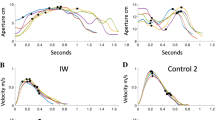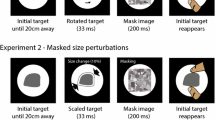Abstract
In this study we investigated the role of proprioception in the control of prehension movements, with particular reference to the grasp component. Grasp and transport kinematics were studied in a peripherally deafferented patient and in five healthy subjects. Two experiments were carried out: the prehension experiment and the grasp perturbation experiment. In the prehension experiment both the patient and the control subjects were required to reach and grasp three objects of different size, located at three different distances, both with and without visual feedback. In the grasp perturbation experiment a mechanical perturbation was applied to the fingers during prehension movements, again executed with and without visual feedback. In the prehension experiment temporal parameters of the patient's movements were generally slowed, with greater variability on some measures. However, over the first phase of the movement the pattern of the patient's hand opening and transport acceleration, scaled to object size and distance, was the same as that of controls, both with and without visual feedback. On the contrary, during the final phase of the movement (the finger closure phase and deceleration) the patient's performance differed significantly from the controls. These phases were abnormally lengthened and frequent movement adjustments were observed. In the grasp perturbation experiment the patient was not able to compensate for the perturbations applied to the fingers, even with visual feedback. The data allowed us to investigate also the respective contribution of proprioception and of vision of the hand in the control of prehension. We compared prehension kinematics in two conditions: (a) with visual but no proprioceptive feedback (in the patient) and (b) with proprioceptive but no visual feedback (in the controls). In both experiments proprioceptive control was more efficient than visual control. The results of this study are interpreted in favour of the strict dependence of prehension control on proprioception. The first phase of the movement, however, can be appropriately planned and executed without the necessity of either proprioceptive or visual information about the hand.
Similar content being viewed by others
References
Arbib MA (1981) Perceptual structures and distributed motor control. In: Brooks VB (eds) Motor control. (Handbook of physiology, sect 1, The nervous system, vol II, part 2) William and Wilkins, Baltimore, pp 1449–1480
Chieffi S, Gentilucci M (1993) Coordination between the transport and the grasp components during prehension movements. Exp Brain Res 94:471–477
Chieffi S, Fogassi L, Gallese V, Gentilucci M (1992) Prehension movements directed to approaching objects: influence of stimulus velocity on the transport and the grasp components. Neuropsychologia 30:877–897
Cruse H (1986) Constraints for joint angle control of the human arm. Biol Cybern 54:125–132
Gentilucci M, Castiello U, Corradini ML, Scarpa M, Umilta' C, Rizzolatti G (1991) Influence of different types of grasping on the transport component of prehension movements. Neuropsychologia 29:361–378
Gentilucci M, Chieffi S, Scarpa M, Castiello U (1992) Temporal coupling between transport and grasp components during prehension movements: effects of visual perturbation. Behav Brain Res 47:71–82
Ghez C, Gordon J, Ghilardi MF, Christakos CN, Cooper SE (1990) Roles of proprioceptive input in the programming of arm trajectory. Cold Spring Harb Symp Quant Biol 55:837–847
Jakobson LS, Goodale MA (1991) Factors affecting higher-order movement planning: a kinematic analysis of human prehension. Exp Brain Res 86:199–208
Jeannerod M (1984) The timing of natural prehension movements. J Mot Behav 16:235–254
Jeannerod M (1988) The neural and behavioural organization of goal-directed movements. Clarendon, Oxford
Jeannerod M, Michel F, Prablanc C (1984) The control of hand movements in a case of hemianaesthesia following a parietal lesion. Brain 107:899–920
Lashley KS (1917) The accuracy of movement in the absence of excitation from the moving organ. Am J Physiol 43:169–194
Luria AR (1973) The working brain. An introduction to neuropsychology (English translation) Penguin Books, London
Mott FW, Sherrington CS (1895) Experiments upon the influence of sensory nerves upon movement and nutrition of the limbs. Proc R Soc Lond [Biol] 57:481–488
Paulignan Y, Mackenzie C, Marteniuk R, Jeannerod M (1991a) Selective perturbation of visual input during prehension movements. 1. The effects of changing object position. Exp Brain Res 83:415–451
Paulignan Y, Jeannerod M, Mackenzie C, Marteniuk R (1991b) Selective perturbation of visual input during prehension movements. 1. The effects of changing object size. Exp Brain Res 87:407–420
Polit A, Bizzi E (1979) Characteristics of the motor programs underlying arm movements in monkeys. J Neurophysiol 42:183–194
Rizzolatti G, Camarda R, Fogassi L, Gentilucci M, Luppino G, Matelli M (1988) Functional organization in inferior area 6 in the macaque monkey. II. Area F5 and the control of distal movements. Exp Brain Res 71:491–507
Rothwell JC, Taub MM, Day BL, Obeso JA, Thomas PK, Mardsen CD (1982) Manual motor performance in a deafferented man. Brain 105:515–542
Sanes JN, Mauritz KH, Dalakas MC, Evarts EV (1985) Motor control in humans with large-fiber sensory neuropathy. Hum Neurobiol 4:101–114
Schmidt RA, Zelaznik H, Hawkins B, Frank JS, Quinn JT (1979) Motor output variability: a theory for rapid motor acts. Psychol Rev 86:415–451
Soechting JF, Flanders M (1989) Sensorimotor representations for pointing to targets in three-dimensional space. J Neurophysiol 62:582–594
Taub E, Goldberg IA, Taub P (1975) Deafferentation in monkeys: pointing at a target without visual feedback. Exp Neurol 46:178–186
Von Hofsten C, Ronnqvist L (1988) Preparation for grasping an object: a development study. J Exp Psychol 4:610–621
Woodsworth RS (1899) The accuracy of voluntary movements. Psychol Res Monogr [Suppl] 3:1–114
Author information
Authors and Affiliations
Rights and permissions
About this article
Cite this article
Gentilucci, M., Toni, I., Chieffi, S. et al. The role of proprioception in the control of prehension movements: a kinematic study in a peripherally deafferented patient and in normal subjects. Exp Brain Res 99, 483–500 (1994). https://doi.org/10.1007/BF00228985
Received:
Accepted:
Issue Date:
DOI: https://doi.org/10.1007/BF00228985




